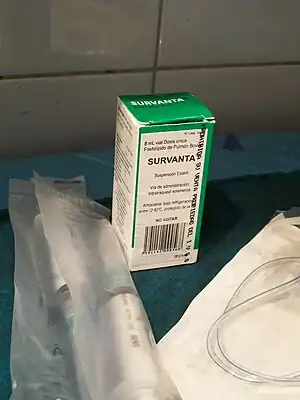Pulmonary surfactant (medication)
 Beractant, surrounded by devices for its application. | |
| Names | |
|---|---|
| Pronunciation | Curosurf, Survanta, others |
| Other names | Beractant, Poractant alfa, others |
| Clinical data | |
| Defined daily dose | not established[1] |
| External links | |
| AHFS/Drugs.com | Monograph |
| US NLM | Pulmonary surfactant (medication) |
| Legal | |
| License data | |
Pulmonary surfactant is used as a medication to treat and prevent respiratory distress syndrome in newborn babies.[2] Prevention is generally done in babies born at a gestational age of less than 32 weeks.[2] It is given by the endotracheal tube.[2] Onset of effects is rapid.[3] A number of doses may be needed.[3]
Side effects may include slow heart rate and low oxygen levels.[2] Its use is also linked with intracranial bleeding.[2] Pulmonary surfactant may be isolated from the lungs of cows or pigs or made artificially.[2][4][5]
Pulmonary surfactant was discovered in the 1950s and a manufactured version was approved for medical use in the United States in 1990.[4] It is on the World Health Organization's List of Essential Medicines.[6] In the United Kingdom it costs the NHS 281.64 to 547.40 pounds per dose.[2]
Medical uses
Pulmonary surfactant is used to treat and prevent respiratory distress syndrome in newborn babies.[2] Prevention is generally done in babies born less than 32 weeks gestational age.[2] Tentative evidence supports use in drowning.[7]
Dosage
The defined daily dose is not established.[1]
Types
There are a number of types of pulmonary surfactants available. Like their natural counterparts, pulmonary surfactant preparations consist of phospholipids (mainly DPPC) combined with spreading agents such as SP-B and SP-C.[8]
Synthetic pulmonary surfactants:
- Colfosceril palmitate (Exosurf) - a mixture of DPPC with hexadecanol and tyloxapol added as spreading agents
- Pumactant (Artificial Lung Expanding Compound or ALEC) - a mixture of DPPC and PG
- Lucinactant (KL-4) - composed of DPPC, palmitoyl-oleoyl phosphatidylglycerol, and palmitic acid, combined with a 21 amino acid synthetic peptide (sinapultide) that mimics the C-terminal helical domain of SP-B.[9]
- Venticute - DPPC, PG, palmitic acid and recombinant SP-C
- Lucinactant (trade name Surfaxin) is a liquid medication that contains DPPC, POPG as the sodium salt, and palmitic acid.
Animal derived surfactants:
- Beractant
- (Alveofact) - extracted from cow lung lavage fluid, manufacturing by Boehringer Ingelheim
- (Survanta) - extracted from minced cow lung with additional DPPC, palmitic acid and tripalmitin, manufacturing by Abbvie
- (Beraksurf) - extracted from minced cow lung with additional DPPC, palmitic acid and tripalmitin, manufacturing by Tekzima
- Calfactant (Infasurf) - extracted from calf lung lavage fluid
- Poractant alfa (Curosurf) - extracted from material derived from minced pig lung
History
Researcher John Clements identified surfactants and their role in the 1950s. Mary Ellen Avery soon after showed that the lungs of premature infants couldn't produce surfactants.[10]
Exosurf, Curosurf, Infasurf, and Survanta were the initial surfactants FDA approved for use in the U.S.[11]
In 2012, the US FDA approved an additional synthetic surfactant, lucinactant (Surfaxin).
References
- 1 2 "WHOCC - ATC/DDD Index". www.whocc.no. Archived from the original on 1 July 2021. Retrieved 15 September 2020.
- 1 2 3 4 5 6 7 8 9 British national formulary : BNF 69 (69 ed.). British Medical Association. 2015. p. 217. ISBN 9780857111562.
- 1 2 Fanaroff, Avroy A.; Fanaroff, Jonathan M. (2013). Klaus and Fanaroff's Care of the High-Risk Neonate, Expert Consult - Online and Print,6: Klaus and Fanaroff's Care of the High-Risk Neonate. Elsevier Health Sciences. p. 252. ISBN 1416040013. Archived from the original on 2017-01-09.
- 1 2 Lantos, John D.; Meadow, William L. (2006). Neonatal Bioethics: The Moral Challenges of Medical Innovation. JHU Press. pp. 54–56. ISBN 9780801883446. Archived from the original on 2017-01-09.
- ↑ Slonim, Anthony D.; Pollack, Murray M. (2006). Pediatric Critical Care Medicine. Lippincott Williams & Wilkins. pp. 724–725. ISBN 9780781794695. Archived from the original on 2017-01-09.
- ↑ World Health Organization (2019). World Health Organization model list of essential medicines: 21st list 2019. Geneva: World Health Organization. hdl:10665/325771. WHO/MVP/EMP/IAU/2019.06. License: CC BY-NC-SA 3.0 IGO.
- ↑ Brady, Bill; Charlton, Nathan P.; Lawner, Benjamin J.; Sutherland, Sara F. (2012). Cardiac Arrest, An Issue of Emergency Medicine Clinics. Elsevier Health Sciences. p. 175. ISBN 1455742767. Archived from the original on 2017-01-09.
- ↑ Nkadi, Paul O.; Merritt, T. Allen; Pillers, De-Ann M. (2009). "An overview of pulmonary surfactant in the neonate: Genetics, metabolism, and the role of surfactant in health and disease". Molecular Genetics and Metabolism. 97 (2): 95–101. doi:10.1016/j.ymgme.2009.01.015. ISSN 1096-7192. PMC 2880575. PMID 19299177.
- ↑ "KL4 Surfactant Technology - Windtree Therapeutics, Inc". Windtree Therapeutics, Inc. Archived from the original on July 29, 2018. Retrieved 29 November 2017.
- ↑ Palca, Joe (3 August 2015). "How A Scientist's Slick Discovery Helped Save Preemies' Lives". NPR. Archived from the original on 3 August 2015. Retrieved 3 August 2015.
- ↑ Taeusch, H William; Lu, Karen; Ramierez-Schrempp, Daniela (2002). "Improving pulmonary surfactants" (PDF). Acta Pharmacologica Sinica. 23 Suppl: 11–5. Archived (PDF) from the original on 2015-03-01.
External links
| Identifiers: |
|---|
- "Poractant alfa". Drug Information Portal. U.S. National Library of Medicine. Archived from the original on 2019-12-31. Retrieved 2019-12-31.
- "Beractant". Drug Information Portal. U.S. National Library of Medicine. Archived from the original on 2019-12-31. Retrieved 2019-12-31.
- "Calfactant". Drug Information Portal. U.S. National Library of Medicine. Archived from the original on 2019-12-31. Retrieved 2019-12-31.